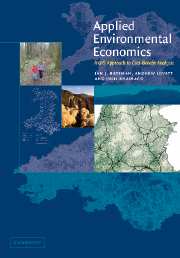Book contents
- Frontmatter
- Contents
- List of plates
- List of figures
- List of tables
- Foreword by David W. Pearce
- Preface
- Acknowledgements
- 1 Introduction
- 2 Recreation: valuation methods
- 3 Recreation: predicting values
- 4 Recreation: predicting visits
- 5 Timber valuation
- 6 Modelling and mapping timber yield and its value
- 7 Modelling and valuing carbon sequestration in trees, timber products and forest soils
- 8 Modelling opportunity cost: agricultural output values
- 9 Cost-benefit analysis using GIS
- 10 Conclusions and future directions
- References
- Index
- Plate Section
5 - Timber valuation
Published online by Cambridge University Press: 22 September 2009
- Frontmatter
- Contents
- List of plates
- List of figures
- List of tables
- Foreword by David W. Pearce
- Preface
- Acknowledgements
- 1 Introduction
- 2 Recreation: valuation methods
- 3 Recreation: predicting values
- 4 Recreation: predicting visits
- 5 Timber valuation
- 6 Modelling and mapping timber yield and its value
- 7 Modelling and valuing carbon sequestration in trees, timber products and forest soils
- 8 Modelling opportunity cost: agricultural output values
- 9 Cost-benefit analysis using GIS
- 10 Conclusions and future directions
- References
- Index
- Plate Section
Summary
Introduction
In this chapter we assess both the social and private value of timber production. This is the major market-priced output of woodland. Furthermore, while recent policy statements from both the National Assembly for Wales (1999, 2001a; Forestry Commission (FC), 2001a, b) and UK government departments (Department for the Environment, Transport and the Regions (DETR), 2000) emphasise the need to adopt a holistic approach to managing woodlands, explicitly recognising their multipurpose nature, timber production remains, nevertheless, a key element of such a strategy, playing an important role in rural economies (FC, 1998).
The economic and policy imperative to include timber production within any cost-benefit analysis of land use change involving forestry is therefore clear. However, the estimated value of this production depends crucially upon the real price of timber. Because plantation returns are long delayed, any (even small) change in real prices will have a major impact upon net present value (NPV) sums. In order to assess this, the chapter opens with a brief history of commercial forestry in the UK designed to acquaint the reader with the recent, major and trend-breaking increase in domestic timber supply. In the subsequent section both the supply and demand sides of the UK market are modelled so that a balanced view on future prices can be derived. These conclusions are reinforced by time-series analyses of price movements.
- Type
- Chapter
- Information
- Applied Environmental EconomicsA GIS Approach to Cost-Benefit Analysis, pp. 111 - 157Publisher: Cambridge University PressPrint publication year: 2003

